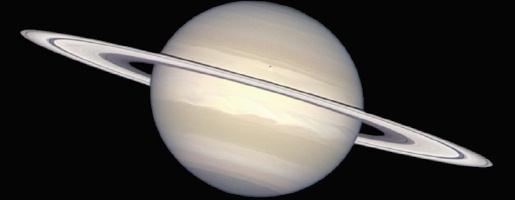 |
||
|
Hubble
Space Telescope true-colour image of Saturn and its ring system.
|
||
| SATURN - THE RINGED GIANT | ||
| Even through a small amateur telescope, Saturn is one of the most impressive sights of the Solar System, and, after the Earth, the one planet that everybody recognises. Saturn is of course famous for its ring system, but as a bright object in the night sky it has been known for thousand of years. | ||
| Saturn's orbit | ||
| Saturn orbits the Sun at a distance of 1,427 million kilometres, just under twice as far as Jupiter. Saturn's orbital eccentricity of 0.055 means the difference between aphelion and perihelion distance has little effect on Saturn. | ||
| Travelling with an average speed of 9.66 kilometres per second, it takes Saturn over 29 years to complete one orbit of the Sun. The length of a Saturn day is 10.5 hours - its rotational spin is similar to Jupiter's. In common with the other gas giants, Saturn bulges slightly at the equator due to its rapid rotation. | ||
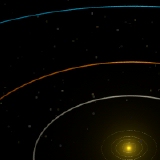 Saturn's orbit. |
||
| Low Density | ||
| Saturn is over 95 times as massive as Earth, and has over 760 times the volume. However, Saturn has the lowest density of the planets. Its average density is less than that of water, and should you find an ocean big enough you could float the planet. | ||
 Comparison between Saturn and Earth. |
||
| Helium rain | ||
| Although Saturn's interior can be modelled using computers, knowledge of the interior is still theoretical. Saturn's interior includes metallic hydrogen, similar to Jupiter's interior, but differs in that Saturn may have internal "helium rain", a feature not found inside the other gas giants. | ||
 Cross-section through Saturn. |
||
| More about Saturn's interior | ||
| Powerful magnetic field | ||
| Saturn has a magnetic field 600 times more powerful than Earth's, generated in the interior of the planet by currents of flowing metallic hydrogen. The interaction between the solar wind and the magnetosphere generates polar aurorae. | ||
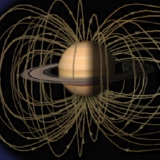 Saturn's magnetosphere. |
||
| More about Saturn's magnetic field | ||
| Severe atmosphere | ||
| Saturn, a gas giant, has a deep atmosphere that has convection and turbulence similar to Jupiter's atmosphere, but lacks the vivid colours and high contrast. Saturn's atmosphere looks calmer, but in reality conditions are very severe. | ||
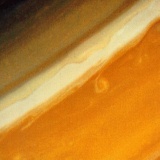 A short-lived storm shaped like the number 6, in Saturn's northern hemisphere. |
||
| Saturn's origin and evolution | ||
| Although the origin of Saturn is fairly well understood, and is similar to the other gas giants, there still remain unanswered questions concerning the origin of the ring system. | ||
 The origin of Saturn's rings, seen here by Voyager, is still unknown. |
||
| More about Saturn's evolution | ||
| Mysterious rings | ||
| The rings of Saturn are, of course, the most impressive aspect of Saturn. Discovered by Galileo in 1610, they were at first misinterpreted, and it was not until 1659 that their true nature was understood. Even now, after spacecraft exploration, our knowledge of the origin and workings of the ring system is still uncertain. | ||
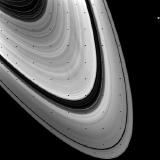 Voyager view of Saturn's ring system. |
||
| More about Saturn's rings | ||
| The moons of Saturn | ||
| Saturn has a large family of moons. Although many are small and geologically dead, the largest, Titan, is one of the most interesting. Titan may have liquid oceans, and consequently is one of the targets of the Cassini-Huygens mission now en route to Saturn. | ||
 Montage of Saturn's major moons. |
||
| More about Saturn's moons. | ||
| Exploration of Saturn | ||
| As well as being the subject of ground-based telescopic observation for centuries, Saturn has been visited by spacecraft. The Cassini spacecraft is on its way towards Saturn, and scheduled to enter Saturnian orbit in June 2004. | ||
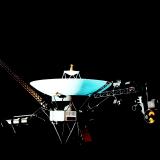 The Voyager spacecraft. |
||
| More about the exploration of Saturn | ||
|
|
||